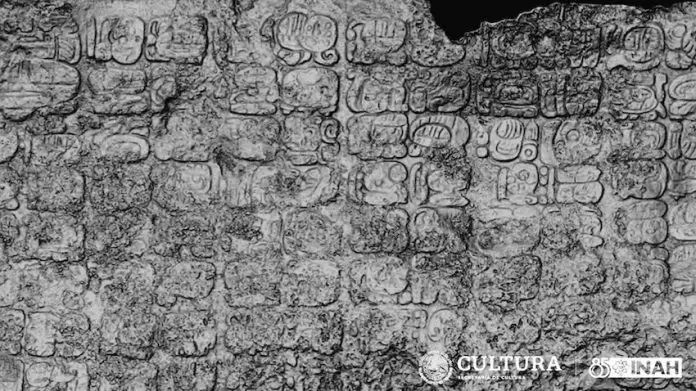Archaeologists from the National Institute of Anthropology and History (INAH) have unearthed a newly discovered Maya stela in the Cobá archaeological zone in Quintana Roo bearing extensive hieroglyphics describing the founding of a Maya city.
The finding is one of the most “remarkable discoveries” the institute has made during the construction work of the Maya Train, head of the INAH Diego Prieto Hernández told reporters on Tuesday during President Andrés Manuel López Obrador’s morning press conference.

Located near the popular Nohoch Mul, one of the tallest pyramids on the Yucatán Peninsula, the stela is over 11 meters long and contains 123 carved hieroglyphics arranged in quadrants. According to INAH’s preliminary analysis, the hieroglyphics appear to describe the founding of the Maya settlement of Keh Witz Nal (Deer Mountain) on May 12, A.D. 569.
The inscriptions also reveal the name of a previously unknown ruler, K’awiil Ch’ak Chéen, filling a gap in archaeologists’ knowledge about the dynastic sequence of Cobá.
Cobá is an ancient Maya city in Quintana Roo that contains many engraved and sculpted stelae that document ceremonial life and important events of the Late Classic Period (AD 600–900) of the Mayan civilization.
According to Prieto, the newly discovered stela sheds more light on the ancient Maya’s worldview and ritual practices. It confirmed, for instance, that many of the region’s rulers adopted the name of the god K’awiil, believing it conferred upon them the attributes of the protective deity that the Maya associated with meteorological phenomena and abundant harvests.
To restore and protect the artifact—which was found covered with salt, weeds and soil—archeologists have injected lime mortar into it to reinforce the stela’s interior, which had developed external holes due to stagnant water collecting on it during rainy seasons. Researchers also have made a high-precision record of the hieroglyphics to create 3-D models of the artifact that will aid in further investigation.
See INAH researchers working at the site of the stela’s discovery at the Cobá archeological zone.
In recent years, construction work on the government’s Maya Train — the tourist train that runs through the southern states of Chiapas, Tabasco, Campeche, Yucatán and Quintana Roo — has uncovered several ancient Maya artifacts, which Prieto called “the greatest archaeological treasure” of the last few decades.
Many of the discoveries made along the train route are now exhibited in the new Gran Museo Maya de Chichén Itzá (Chichén Itzá Maya Museum).
Mexico News Daily
